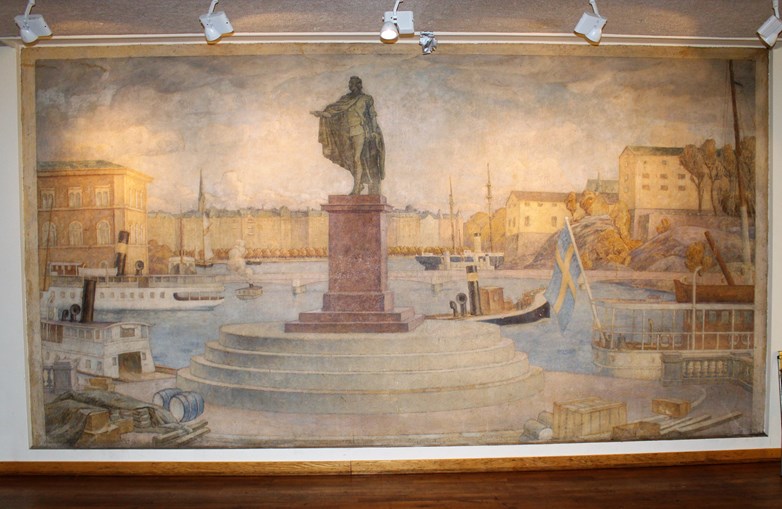Prince Eugen: Stockholms ström
The 2.5 by 3.5 meter fresco Stockholms ström (Stockholm’s Stream) by Prince Eugen was commissioned for the building at Holländargatan 32–34 in central Stockholm. At the time, the space was used by student unions connected to both the Stockholm School of Economics (SSE) and Stockholm University. The painting was created as part of a broader effort to furnish and elevate the interiors of the buildingn soon after its inauguration.
When SSE purchased the property in 1986, the mural was restored, and the room it occupies was renamed “The Prince’s Gallery.” The name also nods to a similar commission by Prince Eugen in Stockholm City Hall, a gallery space that shares both his authorship and a related approach to theme and composition.
Prince Eugen (1865–1947) was both a professional painter and a member of the Swedish royal family. His position gave him financial independence, but also came with official duties and social expectations that often limited his ability to focus fully on his artistic work. Despite this, he maintained a lifelong commitment to painting, primarily landscapes.
Over the course of his career, his style shifted from romantic depictions of forests and skies to more subdued and structured compositions. The mural at SSE reflects this later period. Like many of his paintings, it draws on locations familiar to him—around Stockholm and Tyresö, where he spent summers—as well as views from travels in Italy. After his death, his home at Waldemarsudde on Djurgården was opened as a museum. Today it houses a significant collection of his work and those of artists he supported, and remains largely preserved in its original form.
Stockholms Ström
Eugen, Prince of Sweden 1865-1947, 1936
Fresco, 250 x 350 cm
An impression
By Staffan Alsparr
In a brightly overcast day of early spring or fall, we stand with the artist in Gamla stan ("Old Town"), looking out over the inner harbor of Stockholm. The view is very similar to what can be seen from the same point today, ninety years since the painting was executed, featuring iconic buildings such as the National Museum to the left and the facades of Strandvägen in the background. To the right are what used to be storage houses in the prince's day, but which now house the Museum of Far Eastern Antiquities. The main actors of the scene, however, are all the boats going about their daily business. Not a single human being is visible in the painting and yet we feel the hustle and bustle of human life. The boats almost seem to substitute people, expressing individuality and personality in themselves with their various shapes and sizes. Similarly, the trees on Skeppsholmen to the right, seem to relish in their variety, dancing rhythmically across the cliffs of the island. The trees along Strandvägen, however, look like they are waiting in line, or perhaps enjoying the view, much like we do from the other side of the harbor.
There is a lot of movement in the scene, but then, dominating the centre, we find the statue of the old king Gustav III, frozen in his step. His gesture seems to be one of offering something, perhaps inviting us to enjoy this view of the city. One contemporary critic saw the figure as representing the bright and festive era of the 18th century poet Bellman. The same critic noted that the painting seems to exude distinct smell of brackish water of the Stockholm inner harbor. In that way, it is a reminder of the very local placement of SSE, in the school's global outreach and interconnectedness.
The painting's matte surface harmonizes with its pastel tones. The overall color-chord resounds between the ochre of the stonework and the blue of the waters. The same tones are collected in the flag hanging from the aft of one of the boats, turning it into something of a mirror, or distillate of the whole, perhaps. It is interesting to note, finally, how the painting harmonizes with the light coming in through the wide windows of the room and the vegetation in the park outside, lending the room an air of tranquility.
Sources:
https://runeberg.org/ordochbild/1936/0029.html
"Stockholm School of Economics. The First 100 Years"
